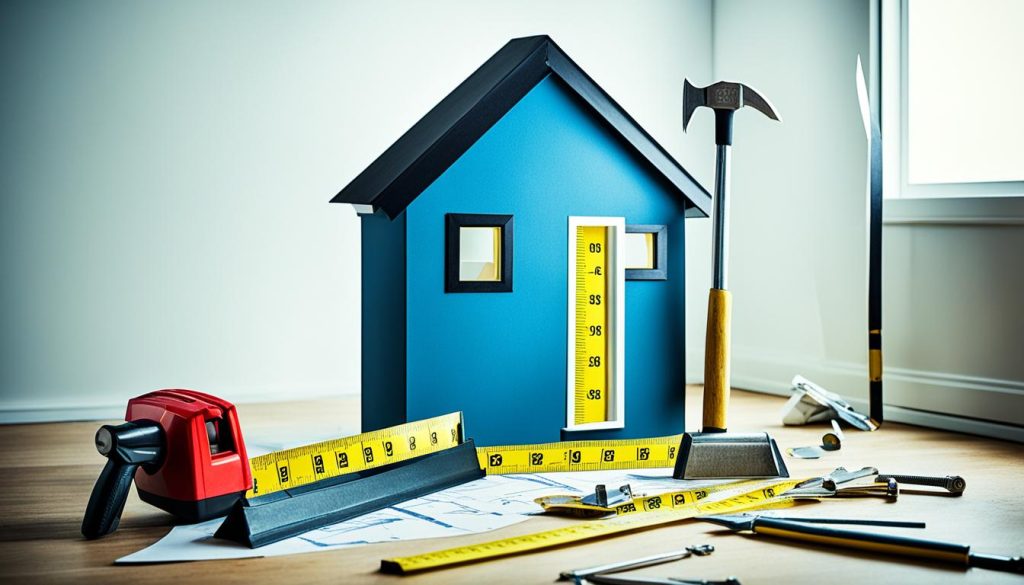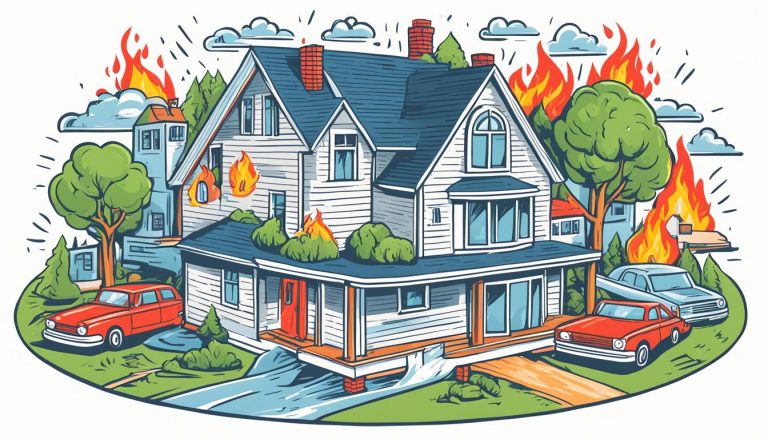Whether you own a big office block or a cosy home, it’s vital to protect your place. Building insurance is key to keep your investment safe from unexpected events. But, how do you figure out the right cost for building insurance in the UK? This guide looks into the different factors that impact premiums. It’s here to help you get the best cover without breaking the bank.
The price of building insurance is not set in stone. It changes based on many things. The size, building type, and where it is all affect the cost. Insurers look at a lot to work out the risk of insuring your building. This includes how old it is, its condition, and even the area’s safety from things like natural disasters or crime.
No matter what type of space you’re insuring, knowing these factors is crucial. It can make finding the right policy easier. This guide aims to show you how to make smart choices about your building insurance in the UK. It’s all about protecting what’s yours while being budget-savvy.
How Much for Building Insurance in the UK?
Building insurance costs in the UK change a lot. This is because each property has its own risks. Insurers look at these risks when they decide how much to charge. Knowing what affects the cost can help property owners get better prices.
Factors Impacting Building Insurance Premiums
Insurers think about how big and how old a building is. Bigger and older places usually cost more to insure. This is because they might need more repairs or could get damaged easier. The materials a building is made of matter too. Buildings made with strong materials often cost less to insure.
Where a building is located is very important as well. If it’s in an area that floods a lot or has a high chance of the ground sinking, insurance is more expensive. The use of the building matters too. Places used for businesses or industry usually have higher insurance costs than homes.
Regional Variations in Insurance Rates
The UK shows big differences in building insurance costs between areas. Places with more claims, like where severe weather hits or where structures are old, often have costlier insurance. On the other hand, areas with lower risks can offer better insurance prices.
| Region | Average Building Insurance Premium |
|---|---|
| London | £1,200 |
| South East | £950 |
| North West | £800 |
| Wales | £700 |
This table shows how much building insurance costs in different parts of the UK. To get a good deal, property owners should look around. Getting several quotes is a smart way to find the best price for your building.

Insuring Commercial Properties
Commercial property insurance is a must for places like offices, shops, and factories. Each type of building needs its own special insurance. This is to make sure it’s protected well from lots of risks.
Office Blocks and Retail Spaces
Office buildings and shops have different risks, like fire and theft. They also get risk from customers or tenants making claims. These places need insurance that covers the building and what’s inside. This includes furniture, equipment, and stock. Owners should also think about getting liability insurance. This protects if someone makes a claim against the property.
The latest data shows that in the UK, insuring an office block can cost between £1,500 to £3,000 per £100,000 of coverage. For shops, it could be £2,000 to £4,500 for the same amount of cover.
| Property Type | Average Annual Premium (per £100,000 of coverage) |
|---|---|
| Office Blocks | £1,500 – £3,000 |
| Retail Spaces | £2,000 – £4,500 |
Note, these costs are just average. They can change based on where the property is, its size, and what it’s made of. To get the best deal, get quotes from several insurance companies. This way, you’ll find the best price and coverage for your property.
Protecting Industrial and Warehousing Facilities
Commercial property insurance for industrial and warehousing sites faces unique tests. These areas contain important goods, tools, and materials. They are at risk from many dangers, such as fire, theft, and natural disasters. It’s vital to have the right building insurance costs and construction insurance coverage. This protects the facilities and what they store.
The building insurance quotes for these sites depend on the stored goods. If they deal with dangerous materials or flammable items, the premiums may be higher. Insurers look at the risk of big claims. The security the site has, like alarms and cameras, also affects the business premises insurance costs.
- Type of goods stored
- Security measures
- Building construction and age
- Location and exposure to natural disasters
- Operational risks associated with the facility
The building’s age and how it was made, where it’s placed, and its operations all can affect insurance prices. If it’s in a place where disasters happen often, like floods or earthquakes, the building insurance costs might be more. This is because there’s a higher chance of making claims.
| Factor | Impact on Insurance Costs |
|---|---|
| Type of goods stored | Dangerous goods mean higher premiums |
| Security measures | Good security can lower costs |
| Building age and construction | New and well-kept buildings could have cheaper premiums |
| Location and natural disaster risk | Riskier locations can increase building insurance costs |
| Operational risks | Riskier operations can up commercial property insurance costs |
To get the best insurance, owners need to work with experts. They should balance the right coverage with costs they can afford. Managing risks well and taking steps to lower possible dangers is key. This helps secure a good deal on commercial property insurance for their business sites.

Evaluating Your Building’s Value
Determining your building’s value is key for property coverage. This makes sure you’re protected at the right level. Factors like construction materials, building age, size, and any renovations count.
Also, the location and risks like floods or fires are crucial. They really affect your insurance rates.
Comparing Quotes from Insurers
Once your building’s value is clear, start looking for good insurance rates. Managing risks is essential. Compare quotes from trustworthy insurers to get the best deal.
Look at policy details closely. This means checking coverage limits, deductibles, and any exceptions. It helps find the best mix of protection and value.
Making a list of what you want in a policy can simplify things. Include needs like rebuilding coverage, liability protection, and natural disaster coverage. Knowing what you need makes choosing a policy easier. You can pick the one that gives the most comprehensive coverage for the right price.
Residential Building Insurance
Looking after your home is key. Building insurance is vital, covering against natural or unexpected risks. In the UK, homeowners must think about their insurance needs carefully.
Homeowners’ Insurance Considerations
Choosing the right policy depends on many things. Your home’s size, age, and materials affect the cost. Also, where your home is, its risks, and local insurance history matter.
Think about how much cover you need. This includes your home’s replacement cost, contents value, and any extra protection like liability. Checking policy details is crucial to make sure you have the right building insurance costs and property coverage for your needs.
Getting insurance quotes from lots of companies is vital. This way, you can find the best rates for insuring buildings and home insurance costs. Understanding what affects building insurance costs helps you protect your valuable investment wisely.
| Factors Affecting Residential Building Insurance Costs | Impact on Premiums |
|---|---|
| Property Size | Bigger homes have higher rebuilding costs and so, more expensive insurance. |
| Construction Materials | If your home is made with pricey or special materials, expect higher costs. |
| Property Age | Older homes might need more repairs, making insurance premiums go up. |
| Location Risks | Places at risk from floods or other disasters might have costlier insurance. |
| Claims History | Homes with lots of claims might have to pay more for insurance. |
Risk Management and Building Insurance
Risk management is key in setting how much property owners pay for building insurance. By focusing on lowering risks, owners might pay less for insurance. This also ensures their buildings are well-protected.
Mitigating Risks for Lower Premiums
To cut costs on building insurance, concentrate on risk management. Property owners can take steps to reduce potential risks. Doing this shows insurers the building is safe and well-kept. Here are some important steps:
- Update security systems like alarms and cameras, to stop break-ins and vandalism.
- Make the fire safety better by having good detection and putting out fires systems. Also, make sure these are checked regularly and staff know what to do in a fire.
- Check that the building’s structure and electrics are looked after, to fix problems before they get big.
- Have a plan for disasters, so people can leave safely and there’s a backup if the power goes out.
- Have different kinds of businesses in a building, so losing one won’t cause too much financial harm.
Showing you’re serious about managing risks can lower your insurance costs. Insurers will see the effort you’re making to keep the building safe. This could mean better insurance rates.
| Risk Management Strategy | Potential Impact on Insurance Premiums |
|---|---|
| Upgrading security systems | Less chance of vandalism and break-ins, so insurance costs less |
| Improving fire safety | Less risk of fires means cheaper premiums |
| Regular building maintenance | Finding and fixing issues early on could mean fewer claims, saving you money |
| Disaster preparedness planning | Being ready for emergencies cuts the risk of big damage or business problems, making insurance more affordable |
| Diversifying tenant mix | If one business leaves, you won’t lose too much money, which affects how much you pay for insurance |
By using these risk management methods, you show insurers you’re actively protecting your building. This can lead to paying less for property insurance and construction insurance. It’s a smart move for building risk insurance and risk management.

Conclusion
Building insurance costs in the UK can change a lot. This is based on many things. These include the size, type, location of the property, and the risks involved. When you insure a building like an office, a warehouse, or your home, it’s important to think carefully. Make sure you get the best coverage for a good price.
We talked about what affects the cost of building insurance. This includes property value, risk levels, and where your property is. By knowing these, you can choose well when comparing insurance quotes. Pick the one that fits what you need the most.
It’s key to keep checking your building insurance. Why? Because things can change with your property, the insurance market, and the risks you face. Be alert, look for better deals, and choose trusted insurers. This strategy helps you get the best and most affordable protection for your buildings. With this care, your investment will be safe from many risks.
FAQ
How do regional variations affect building insurance rates in the UK?
Building insurance rates change a lot between UK regions. This is because of different local economies and crime rates. Things like natural disaster risks also play a part. Plus, how many insurance companies are competing in the area affects prices.
What types of commercial properties require specialised insurance coverage?
Places like office blocks, shops, factories, and warehouses need special insurance. They face specific risks that normal policies might not cover. These commercial properties require unique insurance plans.
How can industrial and warehousing facilities manage their building insurance costs?
Warehouses and other industrial sites can lower their insurance costs. This is by managing risks well. Things like what they store and security measures matter a lot. They should focus on keeping their operations safe.
What should homeowners consider when purchasing building insurance?
When buying insurance, homeowners should think about their property’s worth. They should also look at the risks it has. Getting quotes from different insurers helps find the best policy. It should cover what’s needed at the best price.
How can property owners reduce their building insurance premiums?
To reduce insurance costs, owners can do a few things. They can make the property safer. This includes better security and fire safety. They can also improve the building’s materials. These steps help lower insurance prices.






